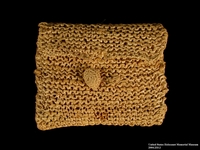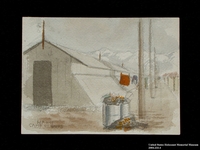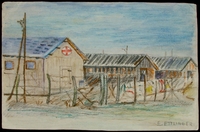Overview
- Brief Narrative
- Colored pencil and ink drawing made for 16 year old Johanna Hirsch by another prisoner, E. Ettlinger, in Camp de Gurs, France, where she was interned from 1940-1941. It depicts the tombstones of three friends who died at the camp, Rosa Adler, Herbert Mecklenberg, and Peter Meier. See 2004.233.4 and 5 for other drawing by Ettlinger. For Hanne, one of the worst things about the camp was that there was nothing for the inmates to do. Many crafted items to fight the tedium, and also to possibly earn a few pennies or barter with the items. Hanne and her mother Ella were deported from Karlsruhe, Germany, to Gurs in October 1940. In September 1941, Hanne was rescued from the camp by OSE (Oeuvre Secours aux Enfants/ Aid to Children) and placed in a children's home in Le Chambon. When the Germans started rounding up Jews in the countryside, OSE found Hanne hiding places on two farms. In 1943, Hanne obtained false identity papers and escaped over the Alps to Switzerland. After the war ended in May 1945, Hanne married Max Liebmann, a fellow deportee from Germany whom she had met in Gurs. Ella had been deported and killed in Auschwitz concentration camp. Hanne and Max emigrated to the United States in 1948.
- Artwork Title
- Those Left Behind
- Date
-
creation:
1940 October-1941 September
- Geography
-
creation:
Gurs (Concentration camp);
Gurs (France)
depiction: Gurs (Concentration camp); Gurs (France)
received: Gurs (Concentration camp); Gurs (France)
- Credit Line
- United States Holocaust Memorial Museum Collection, Gift of Johanna Hirsch Liebmann
- Contributor
-
Artist:
E. Ettlinger
Subject: Johanna E. Liebmann
- Biography
-
Johanna (Hanne) Eva Hirsch was born on November 28, 1924, in Karlsruhe, Germany, to Jewish parents, Max and Ella. Max was a photographer and operated a photographic studio. When Max died in 1925, Elle continued to operate the studio. In 1930, Hanna entered the public elementary school. In January 1933, Hitler became Chancellor of German and anti-Jewish repressions intensified throughout the country. The Hirsch studio and other Jewish businesses in Karlsruhe were covered with signs telling people not to use Jewish stores. Hanne was taunted by classmates for being a Jew and, once, became so angry she ripped the sweater of her tormentor. Ironically, the photo studio had an upsurge of business after the November 9-10 Kristallnacht pogrom as Jews were required to get new identification cards marked “J” for Jew. The studio and all other Jewish businesses were ordered to shut down on December 31, 1939.
In October 1940, Hanne and Ella were deported to Camp de Gurs in Vichy France near the Spanish border. While in the camp, Hanne met Max Liebmann, born in 1921 in Mannheim, Germany, who had been deported to Gurs with his mother on October 22, 1940. Hanne heard about a pastor in the nearby village, Le Chambon, who helped get children out of the camp. He worked with a Jewish rescue agency, Oeuvre de Secours aux Enfants (OSE/ Aid to Children). In September 1941, OSE rescued Hanne from Gurs where they had begun to deport prisoners to the concentration camps in Poland. Hanne was hidden in a children’s' home in Le Chambon-sur-Lignon run by Albert Bohny. By 1942, the Germans were beginning to round-up Jews in the southern countryside and Hanne was placed in hiding on two different farms, whose owners generously shared what they had with the refugees.
In 1943, Hanne obtained false papers in Le Chambon as a French girl and the underground arranged to help her get to Switzerland where she had a maternal aunt. With an escort from the underground, Hanne journeyed by train from Lyon to Annecy, and then walked from there to Annemasse where her papers were examined by a customs officer who asked her if she was Jewish. She denied being a part of the ‘dirty race” and with a slight smile, he let her continue. She was supposed to stay in a convent, but they decided not to take her in. Her escort found her lodging for the night and the next morning went with her to the convent and the nuns then helped her get to Tourneau. A priest hired by her uncle then guided her across the Swiss border with a group of other Jews on February 23. She lived for a while with her uncle, aunt, and cousin and attended school until she became ill with pneumonia. For a while, she worked on a farm as part of a Swiss program that drafted teenagers to work with farmers. Hanne had been classed as an emigrant, thus was able to move around to various cities and obtain employment. She had to renew her visa every six months and would be interviewed and asked when she expected to leave Switzerland. In 1944, she moved from Bern to Geneva where she worked as a household maid and boarded with some Bulgarian refugees. She re-encountered Max Liebmann, who was there on a pass from a refugee internment camp to take a social work course.OSE had also rescued Max from Gurs in July 1942 by placing him at a farm operated by orthodox French-Jewish Boy Scouts. When the Germans raided the camp in August 1942, Max escaped to Le Chambon-sur-Lignon. He hid there for four weeks, then with false identity papers, fled over the Alps to Switzerland.
Hanne and Max married in Geneva on April 14, 1945. The couple had a daughter in 1946. They learned that Johanna’s mother had been deported and murdered in Auschwitz concentration camp in Poland. Max’s mother and father met a similar fate. Hanne’s brother, who had emigrated ot the US in 1937, had joined the US Army and been killed in the Battle of the Bulge. In 1948, a cousin in the US provided an affidavit of support and the couple emigrated to the United States. The Swiss would not permit Max to withdraw his money from the bank. He consulted a lawyer who could withdraw it for him, and the lawyer chose to pay for their journey himself. In 1952, the Swiss finally released his money to Max.
Physical Details
- Classification
-
Art
- Category
-
Drawings
- Object Type
-
Color drawing (lcsh)
- Physical Description
- Drawing in colored pencil and black ink on the top half of a white sheet of paper. It depicts an outdoor scene with three arched tombstones buried in the ground with light brown dirt covered mounds in front of each. Names are printed in black ink on each tombstone: on the left, ADLER / ROSA; in the center: MECKLENBERG / HERBERT / 13- 12-40; on the right: MEIER / PETER /+14. The ground behind the tombstones is covered with tall brown weeds. In the distant background are red rooftops, bare treetops, and a blue sea. There is a handwritten caption below the image, the artist's initials in Hebrew at the lower right corner of the image, and Hebrew characters in the top left corner of the image.
- Dimensions
- overall: Height: 5.500 inches (13.97 cm) | Width: 3.500 inches (8.89 cm)
- Materials
- overall : paper, colored pencil, ink
- Inscription
- front, below image, handprinted in block letters, black ink : WIR SIND NOCH NICHT REIF, DARUM MÜSSEN VIELLE / VONUNS KURZ VOR DEM ZIEL ZURÜCKBELEIBEN. / SIE WEINEN UM UNS, WIE RAHEL UM IHRE KIN= / DER WEINT. [We are not yet mature. Therefore many of us must stay behind before the goal has been reached. They weep for us, just as Rachel cries for her chidlren.]
Rights & Restrictions
- Conditions on Access
- No restrictions on access
- Conditions on Use
- No restrictions on use
Keywords & Subjects
- Topical Term
- Concentration camp inmates as artists--France--Gurs. Concentration camps--Pictorial works. Holocaust, Jewish (1939-1945)--Germany--Personal narratives, Jewish. Jews--Rescue--France--Biography. Women concentration camp inmates--France--Gurs--Biography. World War, 1939-1945--Refugees--Switzerland--Biography.
- Corporate Name
- Gurs (Concentration camp)
Administrative Notes
- Legal Status
- Permanent Collection
- Provenance
- The drawing was donated to the United States Holocaust Memorial Museum in 2004 by Johanna Hirsch Liebmann.
- Funding Note
- The cataloging of this artifact has been supported by a grant from the Conference on Jewish Material Claims Against Germany.
- Record last modified:
- 2023-05-30 16:35:23
- This page:
- https://collections.ushmm.org/search/catalog/irn515324
Download & Licensing
In-Person Research
- By Appointment
- Request 21 Days in Advance of Visit
- Plan a Research Visit
- Request to See This Object
Contact Us
Also in Johanna Hirsch Liebmann collection
The collection consists of a change purse, drawings, correspondence, and documents relating to the experiences of Johanna Hirsch and her family before and during the Holocaust in Karlsruhe, Germany, their deportation to Gurs concentration camp in southern France, and Johanna's escape and travel through France to Switzerland.
Date: 1940-1944

Small straw purse made in Gurs internment camp for a German Jewish prisoner
Object
Small woven straw purse owned by Johanna Hirsch Liebmann made by her mother Ella wile imprisoned in Gurs internment camp in France. It was given to one fo Ella's sisters, Helene Goldstein or Rose Traub, when were also interned in Camp de Gurs. Hanne, 16, also was an inmate of Gurs from 1940-1941. For Hanne, one of the worst things about the camp was that there was nothing for the inmates to do. Many crafted items to fight the tedium, and also to possibly earn a few pennies or barter with the items. Hanne and her mother Ella were deported from Karlsruhe, Germany, to Gurs in October 1940. In September 1941, Hanne was rescued from the camp by OSE (Oeuvre Secours aux Enfants/ Aid to Children) and placed in a children's home in Le Chambon. When the Germans started rounding up Jews in the countryside, OSE found Hanne hiding places on two farms. In 1943, Hanne obtained false identity papers and escaped over the Alps to Switzerland. After the war ended in May 1945, Hanne married Max Liebmann, a fellow deportee from Germany whom she had met in Gurs. Ella had been deported and killed in Auschwitz concentration camp. Hanne and Max emigrated to the United States in 1948.

Watercolor scene of barracks and snowy mountains at Gurs internment camp made by an inmate
Object
Watercolor made for 16 year old Johanna Hirsch by another prisoner, E. Ettlinger, in Camp de Gurs, France, where she was interned from 1940-1941. It depicts barracks with laundry and trash outside and barbed wire fence poles receding towards distant snowcovered mountains. See 2004.233.4 and 5 for other drawing by Ettlinger. For Hanne, one of the worst things about the camp was that there was nothing for the inmates to do. Many crafted items to fight the tedium, and also to possibly earn a few pennies or barter with the items. Hanne and her mother Ella were deported from Karlsruhe, Germany, to Gurs in October 1940. In September 1941, Hanne was rescued from the camp by OSE (Oeuvre Secours aux Enfants/ Aid to Children) and placed in a children's home in Le Chambon. When the Germans started rounding up Jews in the countryside, OSE found Hanne hiding places on two farms. In 1943, Hanne obtained false identity papers and escaped over the Alps to Switzerland. After the war ended in May 1945, Hanne married Max Liebmann, a fellow deportee from Germany whom she had met in Gurs. Ella had been deported and killed in Auschwitz concentration camp. Hanne and Max emigrated to the United States in 1948.

Colored pencil drawing of barracks at Gurs internment camp made by an inmate
Object
Colored pencil and ink drawing made for 16 year old Johanna Hirsch by E. Ettlinger, another prisoner in Camp de Gurs, France, where she was interned from 1940-1941. It depicts the Red Cross building and two barracks at the camp. See 2004.233.4 and 5 for other drawing by Ettlinger. For Hanne, one of the worst things about the camp was that there was nothing for the inmates to do. Many crafted items to fight the tedium, and also to possibly earn a few pennies or barter with the items. Hanne and her mother Ella were deported from Karlsruhe, Germany, to Gurs in October 1940. In September 1941, Hanne was rescued from the camp by OSE (Oeuvre Secours aux Enfants/ Aid to Children) and placed in a children's home in Le Chambon. When the Germans started rounding up Jews in the countryside, OSE found Hanne hiding places on two farms. In 1943, Hanne obtained false identity papers and escaped over the Alps to Switzerland. After the war ended in May 1945, Hanne married Max Liebmann, a fellow deportee from Germany whom she had met in Gurs. Ella had been deported and killed in Auschwitz concentration camp. Hanne and Max emigrated to the United States in 1948.
Johanna Hirsch Liebmann papers
Document
The papers consists of documents and correspondence relating to the experiences of Johanna Hirsch Liebmann living under Nazi rule in Karlsruhe, Germany, her family's deportation to Camp de Gurs in southern France, and her escape and travels through Le Chambon-sur-Lignon, France, to Switzerland.



